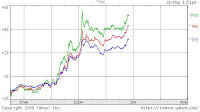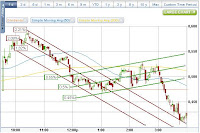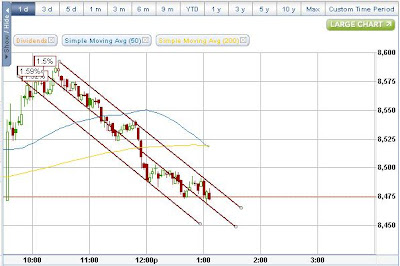Boy have I learned that thoroughly! Take a look at these charts. They are Ultrashort ETFs that are supposed to replicate 200% inverse (double short) of the performance of the underlying indices. They have been quite popular among both retail investors and professional traders since the October/November Cascading Waterfall Crash of 2008, but some pundits (most vocal being
Jim Cramer of Mad Money fame) are increasingly critical of this type of ETFs, blaming them for the terrible market we have had since October.
Below are the charts of the popular (and once popular) double short ETFs.
FXP: Ultrashort FTSE/Xinhua China 25 (high: $183.99, 5/8: $15.20)
EEV: Ultrashort Emerging Markets (high: $207.10, 5/8: $23.52)
SRS: Ultrashort Real Estate (high: $295.72, 5/8: $19.78)
SKF: Ultrashort Financial (high: $303.82, 5/8: $38.94)
SDS: Ultrashort S&P 500 (high: $133.20, 5/8: 56.03)
QID: Ultrashort QQQQ (high: $102.60, 5/8: $37.20)
and to compare that with the general market,
SPY: (long) S&P 500 (9/2: $127.99, 5/8: $92.98)
VIX: CBOE Volatility Index (9/2: 21.99, high: 80.86 (December), 5/8: 32.05)

Despite the market turmoil, the first to whimp out was FXP, as Shanghai Index bottomed in early November. Next in line was EEV, emerging markets double short. Then SRS, commercial real estate double short, even though CRE is every analyst's favorite "next shoe". SKF, financial double short, performed well enough until recently, then went from $250 to $39 in 8 weeks. SDS, double short of S&P 500 index, and QID, double short of Nasdaq, appear to be in better shape than their peers, but compare them to SPY. Despite the recent run, SPY is nowhere near the level of last September (it is down 27%). Yet, SDS and QID are barely hanging on to the unchanged level.
Why this happens is in the very method that these ultrashort ETFs are created. They are meant to follow the daily performance of the underlying indices. Keyword here is DAILY. For more on this, read
here, and
here.
If you didn't know this and held these ETFs as an investment, instead of profiting from the market turmoil you would end up with less money, far less. In order for these short ETFs to work, you need 1) high/increasing volatility; 2)for that volatility to sustain and go up further for some period. Even in such volatile period, if you are not quick enough, you end up losing all the nice fat gains. Take another look at the charts. See the huge spike in prices in October-November period? During that period, these short ETFs acted like OPTIONS. And I think that is what they are: options, without expiration date.

Here's one example of rather absurd outcome: SKF (blue line) vs IYF (red line, long financials ETF, no leverage). Since September last year, IYF has lost 43%. SKF has
lost 63%.
The winning trade, therefore, was to short BOTH.
Double long, or triple long ETFs do not seem to decay as much, though they often "underperform" single ETFs.
So, the lessons learned for me with ultrashort ETFs and triple short ETFs are:
1. Use them only when we have a sustained period of down market. Or day trade. (You really can't beat the thrill of seeing FAZ (triple short financials) go up 25% in a few hours... Oh I talk like a gambling addict, don't I?)
2. It is better to short the long ETFs or underlying stocks, or buy puts (in case of IRA accounts) if you are going to hold short positions for a sustained period of time.
I have traded SDS, SKF (double shorts), SSO (double long), and FAZ (triple short). Miraculously in retrospect, I made money on all of them except SSO (which I got out about even) without quite understanding how these ultrashort ETF behave. Luckily for me, the market was in a severe, sustained downturn.
I still have FAZ, my third purchase, that I'm stuck with. At this point, the share price got so ridiculously low (FAZ went from recent high of $104.07 on March 6 to May 8's $4.49: mind-boggling 96% down in 2 months) I'm keeping it as an amusement to see how low it will go. It will probably go at least as low as FAS, its triple long counterpart, went: $2.64. All the loss on FAZ has been more than made up by hansome gains by FAS. If this rally continues, FAZ will go to ultrashort ETF money heaven. If the bears return in vengeance, my single-digit FAZ can go up 1000% in a few days...


















 The third one is a daily chart of Dow Jones Industrial, from July 1, 2008 to November 24, 2008, flipped upside down and then flipped horizontally.
The third one is a daily chart of Dow Jones Industrial, from July 1, 2008 to November 24, 2008, flipped upside down and then flipped horizontally.
 Companies engaged in industrial materials, energy, and utility make up 70% of the ETF. They have "the stuff", real, tangible goods;I think that's what people are investing in, as they are faced with the prospect of (hyper)inflation.
Companies engaged in industrial materials, energy, and utility make up 70% of the ETF. They have "the stuff", real, tangible goods;I think that's what people are investing in, as they are faced with the prospect of (hyper)inflation.
































